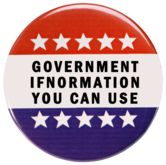|
November 4th is Election Day. This is a time that American citizens can participate in the democratic process by voting for their preferred elected officials. Voting in this country has had its share of challenges, but voting has had a rich history in the United States. The earliest elections were conducted by voice vote or with paper ballots put into ballot boxes. The paper ballots, called party tickets, listed names from just one party. As the United States grew and the electorate expanded after the Civil War, improvements appeared in the Australian or blanket ballot, which listed the names of all candidates and provided ballot boxes with new security features.
Many people vote without thinking about it, but for some the process is new or confusing. USA.gov has resources and information about elections and voting. If you have questions about your polling place, whether an id is required for your state, or to learn about the candidates, CanIVote.org is a nonpartisan website created by state election officials to help eligible voters with information and answer questions about where to vote. The United States Election Assistance Commission also has resources and information for voters such as where to register to vote, how to contact your state election division; and ten tips for voters to lessen any confusion or hesitation about voting. If you have a child, you can teach them about it as well. Ben’s Guide has information about the election process for kids and young adults. It provides resources on voter registration, how the President and Vice President are elected, and many other tools to teach about this important democratic process. For more information about the history of voting and democracy, the Smithsonian National Museum of American history has an interactive display on the Machinery of Democracy. For more information about the election process and voting, visit USA.gov‘s blog on elections and voting.
 |
Election results in the United States have traditionally been reported in local and national newspapers during the week following Election Day. If you need to find results for a particular election, you can generally find candidate information and numbers of votes in historical newspaper articles available at the State Library on microfilm. However, there are also several government agencies that can provide a glimpse at historical election results, as more and more become available online.
The Office of the Clerk for the U.S. House of Representatives has collected and published official vote counts for federal elections from 1920 to 2010. These are available on the office’s website here.
The National Archives and Records Administration has electoral college results for Presidential election years going back to 1789 here.
You can find state-level election data for the past decade through the Indiana Secretary of State’s Election Division here.
The Library of Congress produces the U.S. Election Statistics: A Resource Guide with even more portals to public data about elections, both online and in print.
 |
Indiana citizens can check the website IndianaVoters.com for information about the upcoming election and these other voting topics:
- Confirm Voter Registration
- Review Candidates on the Ballot
- Find Your Polling Place
- See Who Your Elected Officials Are
|